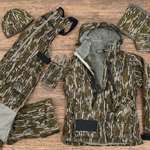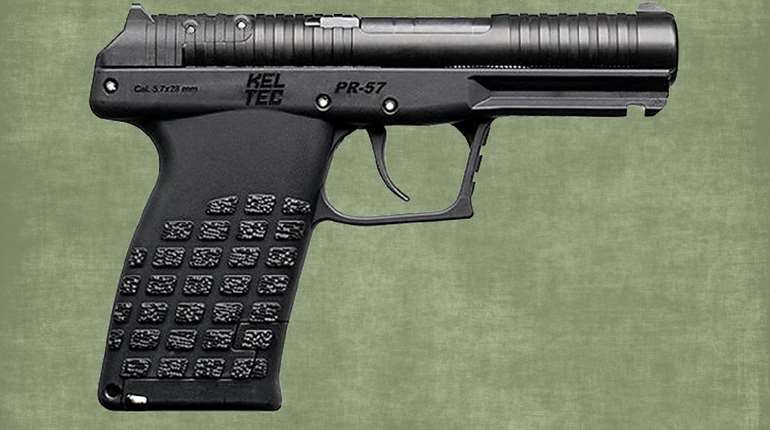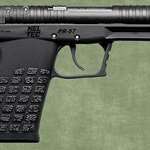
Folks who are new to the shooting sports community may not think of defensive handgun calibers as being “trendy.” But a few calibers with storied histories have moved in and out of vogue over the course of their long service lives. One such cartridge is the .32 ACP. For the last decade or so it has been relegated to the wings of the defensive pistol stage as the popular .380 ACP and the ubiquitous .22 LR have garnered more attention.
However, we've seen a few notable blips on the long dormant .32 ACP heart monitor in the last few months. Beretta breathed fresh life into its tip-up barrel .32-caliber pocket pistol line-up with the release of the threaded-barrel 30X Tomcat. Walther has been fleshing out their sub-caliber semi-automatic catalog with the re-launch of the classic PP, PPK and PPK/S models, including a sporting threaded barrel version, chambered in .32 ACP. And in an unexpected move (at least to me) Federal Ammunition expanded their defensive pistol ammunition line to include a jacketed hollow point .32 ACP load.

From left: 9mm, .380 ACP, .32 ACP, .25 ACP, .22 Mag. and .22 LR.
Since this is the closest we've come to “The Year of the .32 ACP” in quite a while, this seemed like the right time to reflect on this little cartridge's history, talk about a few of the pistols chambered for it and to wring out the new Federal load at the shooting range.
A Bit of Background
The world famous inventor and gunsmith John Moses Browning is still venerated today for his development of the .45 ACP, and the 1911 pistol to launch it, more than a century ago. But what some devotees of this big-bore caliber often over look is that Browning invested just as much time and resources, if not more, into developing pocket pistols and their sub-caliber cartridges. In addition to the .45 ACP (which stands for Automatic Colt pistol), he came up with the .380 ACP, .32 ACP and the .25 ACP, all of which have been concealed carry pistol staples at one time or another.

Although not as popular as it used to be, several ammunition makers still offer .32 ACP defense- and practice-grade ammunition.
Among his earlier cartridges, the .32 ACP was developed in 1899 for FN (Fabrique Nationale) which would produce over half a million pistols in this caliber in the following decade. Browning, Colt and Savage also offered compact-size .32 ACPs intended for law enforcement personnel and civilian self defense. It would become one of the most widely adopted pistol rounds of the time. But the .32 ACP's popularity was overshadowed by the arrival of Browning's .380 ACP cartridge in 1908. The more powerful .380 soon took the lead in the compact frame market while the micro pocket pistol niche would be dominated by the svelte .22 Short, .22 LR and .25-ACP models.
Although the .32 ACP did not fade into the annals of shooting history, it was in a sort of production limbo until 1985. This was the year that L.W. Seecamp Co. launched the diminutive stainless steel LWS-32 chambered in .32 ACP. It was a unique model at that time because it was only slightly larger than the company's .22s and .25s with a notable boost in performance potential. The Seecamp was an immediate hit and the company could not keep up with orders. Soon other manufacturers were on board with this pocket pistol trend launching the previously mentioned Beretta Tomcat, KelTec's polymer-framed P32 and the North American Arms Guardian, which is essentially a clone of the Seecamp.

Developed in 1899, the .32 ACP is among the oldest cartridges still in service today.
The .32s would rule the pocket pistol roost for several years until, once again, the more powerful .380 ACP would take its place. Starting in 2001 with the release of the North American Arms NAA-380, companies began releasing micro .380 ACP pistols that were only slightly larger than their .32s. In 2008 the .380 ACP pocket pistol dam burst when the Ruger LCP arrived on the scene. Over the next few years other gun makers scrambled to catch up with their own offerings. Although there have been some exceptionally small 9mm pistols in the years since, the .380 ACP is still a go-to option for pocket pistols these days.
The “Better” Low-Recoil Option?
The challenge that comes with pocket-sized .380s is that they can be unpleasant to work with, especially for those who are sensitive to recoil. As discussed in this post, a moderately powerful cartridge can generate levels of recoil comparable to more potent cartridges when the pistol used is small and light weight. And even with the compact-size pistols, some folks are still looking for even lower levels of recoil.

Although the selection is not as diverse as some calibers, pistols chambered in .32 ACP are available in compact, subcompact and pocket-pistol sizes.
Those who can't, or choose not to, work with the sometimes snappy little .380s choose to explore sub-caliber pistoloptions. Also known as “mouse guns,” these include pistols chambered in .32 ACP, .25 ACP, .22 Mag. and .22 LR. The sub-calibers are not nearly as popular as they once were. This has reduced the gun and ammunition selections significantly for all but the eminently popular .22 LR. So it's not too much of a surprise when folks go directly from the .380 ACP to defensive rimfire pistols like the compact Taurus TX22 Black and pocket models including the Ruger LCP II, Beretta 21A Bobcat, and the recently released Taurus 22TUC.
However, as discussed in previous posts, small .22 LR pistols are among the least powerful defensive handguns available. They are also inherently less reliable due to the cartridge's rimfire primer. When loaded with purpose-built ammunition, like Federal's Punch round, they can penetrate deeply enough to satisfy typical ballistic gelatin testing protocols. But the bullets do not cause the same degree of target disruption as larger calibers. The .22 LR cartridge launches .223-caliber bullets that commonly weigh somewhere between 32-gr. to 40-gr. that travel at subsonic velocities when fired from short-barrel pistols. The .32 ACP is topped with a .3125-caliber projectile, usually weighing between 55-gr. to 73-gr., which also tend to travel at subsonic speeds.

Beretta’s Model 81 Cheetah once served as a police sidearm.
Are these earth-shattering differences? Not exactly. As we'll see in the performance comparison tables, the .22 and .32-caliber pistols can overlap each other in regards to bullet energy levels at the muzzle. Nevertheless, the .32 ACP has distinct advantages. When bullet velocities are similar, the larger, heavier bullets are more effective. The .32 ACP uses a more reliable centerfire primer and these rounds can be topped off with more sophisticated expanding bullets than the .22 LR.
Old School and New Rule Ammunition Options
When I first looked into .32-caliber pocket pistols about three decades ago, the hollowpoint bullets available in this caliber at that time were iffy when it came to proper expansion. Sometimes they did, sometimes they didn't and for some guns, especially older ones, the bullet shape might not feed properly. With this in mind, I sought out the most energetic full-metal jacket bullet load available at the time. It was the Fiocchi 73-gr. round nose with a listed velocity of 1000 f.p.s. for 162 ft.-lbs. of energy at the muzzle. With small-caliber handguns, ammunition reliability and bullet penetration trump bullet expansion. This round has been utterly reliable and generated some of the highest levels of bullet energy for a non +P load in guns that I've tested.

Walther has revived its lineup of PP, PPK and PPK/S pistols chambered in .32 ACP.
But in this day and age of advanced hollowpoint bullet designs, I've been hoping that some company would come along and give its .32 ACP loads an update, much as was done for the .380 ACP a few years ago. This year, Federal Ammunition did just that. The company has expanded its Personal Defense line of pistol ammunition topped with Hydro-Shok Deep bullets to include a 60-gr. .32 ACP listed at 1000-fps. for 151 ft.-lbs. of energy. Generally speaking, hollow points need to be traveling within a given velocity range in order to expand properly when they impact their intended target. It used to be that those velocities had to be relatively high.
Today, Federal's engineers have the data and expertise required to tune a hollow point to penetrate and expand within the velocity range of a given caliber. In other words, even though the .32 ACP launches lightweight bullets at relatively low velocities, the Hydro-Shok bullet is going to get the job done when fired from the pistols that are currently available. To prove this claim I would need to conduct a set of ballistic gelatin tests, which might be possible sometime in the future. But for this evaluation, the focus was on gathering reliability, accuracy and velocity information at the shooting range.

The KelTec P32 is among the smallest and lightest center-fire pocket pistols available.
With these “Old School” and “New Rule” .32 ACP loads in hand, the Winchester USA practice-grade load was added to complete the three load test set. Topped with a 71-gr. full-metal-jacket bullet, it has a listed muzzle velocity of 905 f.p.s. for 129 ft.-lbs. of energy. Considering how much velocity it dropped when fired from the guns tested, this round is representative of the low end of this caliber's performance spectrum. Ammunition like this is just fine for plinking and target practice but should be avoided for defensive applications.
A Trio of .32 ACP Pistols
The pistols in current production for this caliber draw their design influences from models developed during the .32 ACP’s 20th century heyday or from its pocket pistol renaissance of the 1980s and 1990s. Like the ammunition options, my goal here was to round up three pistols that, if not expansive, are at least inclusive of the .32 ACP models folks will find in the market place.

All three pistols operated reliably with the new Federal load and the other rounds tested.
When the .32 ACP began its military career, early pistol models like the Colt Pocket Hammerless and the Savage Model 1907 had barrels between 3.75" to 4" in length. Since even half an inch of barrel length can change ammunition performance for pistols in this class, I rolled in a not quite vintage Beretta Model 81 Cheetah for the range test. In production from 1976 to 2017, this version of the Cheetah has this company's familiar open top slide, a 3.82" barrel and accepts a double-stack 12-round magazine. The .32 ACP versions are still floating around the surplus pistol market with prices around $400.
Perhaps one of the most famous .32 ACP pistols in movie history (although lots of folks think it's a .380 ACP) is the Walther PPK first issued to super spy James Bond in the film Dr. No (1962). The technician handing Bond this pistol describes it as having, ''... a delivery like a brick through a plate-glass window. The American CIA swear by them." Just to be clear, the Walther was an upgrade to Bond's little .25 ACP which had jammed on a previous mission.

Bullet velocities were measured using a LabRadar LX chronograph.
Virtually unchanged since it entered service in 1929, Walther has steadily offered these guns chambered in .380 ACP and .22 LR for many years. But the .32 ACP has been re-introduced this year. Now it's available in blued and stainless steel configurations in three sizes. The PP is the largest with a 3.9” barrel and an 8-round magazine. The PPK, of Bond movie fame, sports a shorter 3.3" barrel and 7-round magazine. The PPK/s splits the difference between the previous two models with the shorter 3.3" barrel but the longer 8-round magazine. The company kindly sent out a stainless PPK/s for this evaluation which provided the 'mid-length' barrel. It has a suggested retail price of $969.
The smallest pistol on this list is the eminently pocketable KelTec P32. Despite being in production since 1999, the P32 is surprisingly in-step with modern pocket pistol designs. Its features include a slim 0.75” wide steel slide, an aluminum chassis, a textured polymer frame, a double-action only trigger and standard 7-round single-stack magazines. Its claim to fame is an impressively light unloaded weight of 7.9 oz. which goes up to just 8.5 oz. with a Crimson Trace LG-430 Laserguard red laser sight installed (#01-2040-1; $199.99).

The Federal hollow point printed a best 5-shot group of 1.57” when fired from the KelTec P32’s 2.75” barrel.
Not too long after KelTec released the P380 in .380 ACP, I had an opportunity to shoot it and the P32 .32 ACP side-by-side at a gun shop with an attached indoor range. Both pistols fit my hands and exhibited light, smooth triggers, especially for pocket pistols. After shooting through one magazine with the P380, I had little inclination to keep shooting due to the snappy recoil. However, the P32 was much more manageable. About half a box of ammunition later I wanted to keep pulling the trigger. I was sold on the platform, so I purchased the gun and still own it today. The P32 has the shortest barrel of the test set, which is 2.7” long. Occasionally available in various grip-frame colors, the black frame with black slide is currently listed with a suggested retail price of $369.
Range Results
At the shooting range, the new Federal hollow point proved to be utterly reliable in the well broken in Beretta 81 and KelTec P32, along with the factory-fresh Walther PPK/S. It fed, fired and ejected without any malfunctions. The Fiocchi and Winchester loads were just as reliable in their operations. Formal accuracy testing consisted of five 5-shot groups fired at 7 yards. Bullet velocities were measured for 10-shot strings using a LabRadar LX chronograph.
I've conducted several 3-gun evaluations over the years and not seen results quite like this before. Each pistol had one load that was noticeably more accurate than the other two, but it was a different load for each gun. Here are the full range results:



Drawing from this freshly minted set of range test data, let’s see where the .32 ACP lands within the sub-caliber performance range:
Caliber Barrel Length Muzzle Energy Test Gun
.380 ACP 3.54" Barrel: 140 to 180 ft.-lbs. (Walther CCP M2)
.380 ACP 2.75" Barrel: 153 to 179 ft.-lbs. (Ruger LCP Max)
.32 ACP 3.82" Barrel: 112 to 172 ft.-lbs. (Beretta 81 Cheetah)
.32 ACP 3.30" Barrel: 93 to 154 ft.-lbs. (Walther PPK/S)
.32 ACP 2.70" Barrel: 88 to 134 ft.-lbs. (KelTec P32)
.25 ACP 2.40" Barrel: 60 to 72 ft.-lbs. (Beretta Bobcat 21A)
.22 Mag. 4.35" Barrel: 152 to 178 ft.-lbs. (S&W M&P 22 Mag.)
.22 Mag. 2.00" Revolver: 98 to 116 ft.-lbs. (Taurus 942)
.22 LR 4.00" Barrel: 79 to 113 ft.-lbs. (Taurus TX22)
.22 LR 2.75" Barrel: 67 to 73 ft.-lbs. (Ruger LCP II)
Clearly this cartridge does not outperform the popular .380 ACP or larger handgun calibers. However, it can overlap the bullet energy range of the .380 with a longer barrel. There is also an overlap with .22-caliber rimfire pistols sized for concealed carry at the lower end of the .32's range. In short, the data supports the idea that the .32s provide a tangible advantage in bullet mass and cartridge reliability compared to .22-caliber options while providing more modest levels of felt recoil than the .380 ACP.
Parting Shots
Should the .32 ACP pistol cartridge make a comeback? My answer would be yes if we are comparing sub-caliber cartridges to each other and not more powerful caliber options. With more pistols to choose from chambered in .380 ACP and .22 LR, the .32 ACP is often overlooked and under rated when it may be the best centerfire solution for some folks who are seeking a reduced recoil defensive handgun. In order for it to move back into the main stream, two things would have to change. First, more ammunition companies would need to get on board with offering updated defensive loads in this caliber, like the Federal Premium Personal Protection round used in this evaluation. And it wouldn't hurt if they upped their practice-grade load production as well.
Secondly, we would need to see additional up-to-date, polymer-framed pistols outfitted with defensive features folk prefer these days. Right now the selection of pistols is too limited or specialized to draw the interest of the greater low-recoil shooting community. A couple of current production .380 ACP models that could be converted to .32 ACP with relative ease are the top-notch Ruger subcompact Security-380 and the pocket-sized double-stack LCP Max. Considering how manageable these pistols are in their current chambering, a shift to .32 ACP would make them accessible, if not ideal, for folks who might turn to .22 LR models to curb the recoil. Other solid candidates for conversion to .32 ACP would be the Girsan MC14T, Smith & Wesson Bodyguard 2.0 and the Walther CCP, to name a few.
Unfortunately, like any market place, demand drives development. And we may not see enough of demand for the .32 ACP that gun makers and ammunition companies choose to invest in production. And until there is a greater selection of products, interest may remain low. But with this new Federal load, and the bump in interest for the currently available pistols we've seen this last year, there may be just enough momentum to get the .32 ACP ball rolling again. It will be interesting to see what comes next.
















































